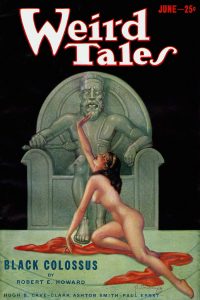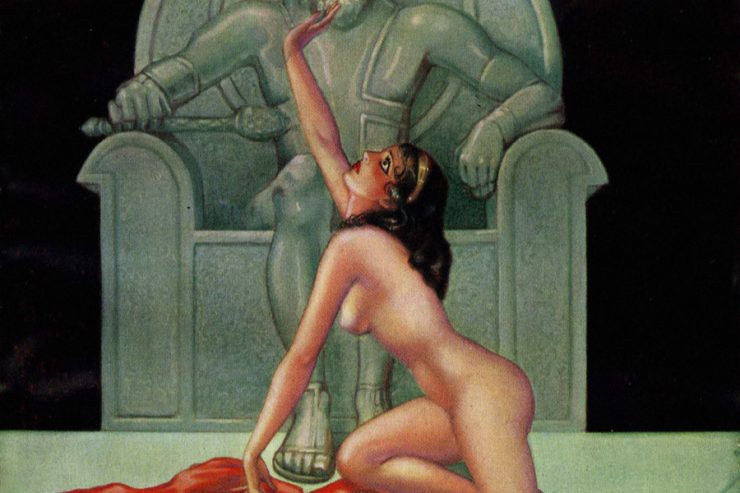 Few artists are as strongly linked to a single pulp as Margaret Brundage is to WEIRD TALES. Dec. 9, 2015, marks the 115th anniversary of her birth in Chicago.
Few artists are as strongly linked to a single pulp as Margaret Brundage is to WEIRD TALES. Dec. 9, 2015, marks the 115th anniversary of her birth in Chicago.
Margaret Brundage got her start in the pulp magazines with WEIRD TALES‘ sister publication, ORIENTAL STORIES (later MAGIC CARPET), with six covers from Spring 1932 through January 1934. Her first cover for “The Unique Magazine” appeared in September 1932. Her pastels graced the cover again the next month, then again in March 1933. Beginning in June 1933 — and for the next 39 covers — WEIRD TALES featured her luscious artwork exclusively. Her last cover for WEIRD TALES appeared on the January 1945 number, capping a run of 66 covers for the magazine, with Brundage receiving no more than $90 for a cover.
The artist’s cover illustration for Robert E. Howard’s “Black Colossus” (WEIRD TALES, June 1933) generated the most mail for any of the magazine’s covers, she told Robert Weinberg, as detailed in THE ALLURING ART OF MARGARET BRUNDAGE, published by Vanguard Productions in 2013.
Brundage always enjoyed illustrating Howard’s stories. It was WEIRD TALES‘ editor Farnsworth Wright who passed along news of Howard’s suicide to the artist in 1936: “When I learned of Robert Howard’s death, I was very upset . . . . (Wright and I) both just sat around and cried for most of the day. He was always my personal favorite.”
In an interview with R. Alain Everts in 1973, Brundage recalled her most controversial WEIRD TALES cover:
We had one issue (the September 1933 number) that sold out! It was the story of a very vicious female, getting ahold of the heroine and tying her up and beating her. Well, the public apparently thought it was flagellation, and the entire issue sold out. They could have used a couple of thousand extra (copies).
In 1938, WEIRD TALES was bought by Short Stories, Inc., and its editorial headquarters moved from Brundage’s hometown of Chicago to New York City. Wright went east with the magazine, but he was suffering from Parkinson’s Disease, and by 1940 he was dead. Brundage stayed in Chicago, but the difficulty of shipping her fragile chalk illustrations by train to New York and a reduction in WEIRD TALES‘ cover rates to $50 ended her pulp career just five years later.
Margaret Brundage died April 9, 1976, at age 75.
PulpFest seeks to draw attention to the profound effect that the pulps had on American popular culture, reverberating through a wide variety of mediums — comic books, movies, paperbacks and genre fiction, television, men’s adventure magazines, radio drama, and even video and role-playing games. Planned as the summertime destination for fans and collectors of vintage popular fiction and related materials, PulpFest honors pulp fiction and pulp art by drawing attention to the many ways the magazines and their creators — people like Margaret Brundage — have inspired writers, artists, film directors, software developers, game designers, and other creators over the decades.
Join PulpFest 2016 to be part of this great celebration of American popular culture. Start making your plans right now to join the 45th convening of “Summer’s Great Pulp Con” in 2016. It will take place July 21–24 at the Hyatt Regency Columbus and the Greater Columbus Convention Center.
Margaret Brundage’s pastel cover for the June 1933 issue of WEIRD TALES illustrates Robert E. Howard’s tale, “Black Colossus.”







